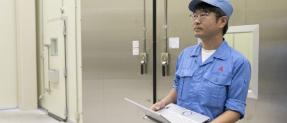INFRASTRUCTURE TO SUPPORT DEVELOPMENT AND DESIGNING

Tsuyoshi Eguchi
Administration Section
Air-Conditioner Designing & Engineering Department

-
Administration Section
Air-Conditioner Designing & Engineering Department *As of 2022Tsuyoshi Eguchi
-
1986
He joined the company. He was assigned to the Takasago Machinery Works Engineering Department Steam Turbine Designing Section.1991
He was assigned to the Technical Headquarters Takasago Research & Development Center Turbomachinery Laboratory2003
Technical Headquarters Takasago Research & Development Center Turbomachinery Laboratory Research Manager2012
He was assigned to the Air-Conditioning & Refrigeration Systems Headquarters Air-Conditioner Designing & Engineering Department Administration Section2017
Team Manager, Air-Conditioner Designing & Engineering Department Administration Section.
Registered as Consulting Engineer (Machine Division)
- Can you tell us the specific details of your department and current work?
-
Establishing infrastructure needed for design work and supporting the streamlining of operations to deal with dramatic advances in the level of development and speed
"30 or 40 years ago, air-conditioners were designed manually. Now we use software, and the level and speed of development have advanced dramatically, raising the burden on individual designers. Our job is to support the streamlining of these operations," says Eguchi. He is a highly experienced employee who has been placed in charge of supporting the designing of air-conditioners since being assigned to the Administration Section in 2012.
Eguchi's role is to carry out vibration analyses on the durability of air-conditioners undergoing development to vibrations, manage the technology for flow analyses to investigate the flow of air inside air-conditioners, and sort and improve the functions of infrastructure required for designing.
"Information sharing infrastructure eliminates the need for conveying matters on projects to individual workers, and responding immediately to individual problems or questions. We're trying to improve efficiency by allowing individual designers to do more and make quick judgments."
He is able to establish infrastructure that meets the needs of designers because of his long years of experience in designing on-site.
- What do you pay particular attention to, or feel confident about in your work?
-
Fostering human resources capable of taking a bird's-eye view of operations to ascertain their true nature
Since joining the company in 1986, he has been involved in designing, research and technological administration. Today, Eguchi even works as an in-house technology instructor. He supervises younger employees based on his own experiences in the past.
"When I take on new work, I too, think about what the purpose of the work is, what the necessities are, and what the effects will be if I didn't do the work. I also advise younger employees to take a moment to think about this before they start working. This is because in my younger days, I too, made the mistake of doing work that was assigned to me in a way that wasn't what I was supposed to do, resulting in a waste of effort."
"I want people to focus not only on what they've been told to do, but think about why, and ascertain what is really required of them. That way, you'll see the bigger picture, which will allow you to find ways to deal with problems when they arise. I place importance on the ability to understand and offer explanations based on reasoning when carrying out work."

- What are your goals and outlook for the future?
-
Aiming to support designing to pass on "fundamentally good designs" based on sound reasoning
Completing the designing of an air-conditioner requires it to pass a variety of tests on performance, noise, etc., but Eguchi says, "It's not just about passing tests. What's important is whether or not it's a 'fundamentally good design' based on sound reasoning."
"I call designs based on sound reasoning, 'fundamentally good designs.' A model may pass tests now, but if it fails future tests after undergoing redesigning, it's not a fundamentally good design. A fundamentally good design will ultimately lead to profitability for the company, so I want to support development to make sure this attitude is passed on to future generations."
He also say he wants to support inexperienced designers by making full use of his knowledge and skills as a highly experienced employee.
"I don't want inexperienced designers to focus too narrowly on what they see right before them. I give them advice on how to make proper use of analyses and systems, so they will remain calm no matter what happens. I want to support them in gaining experience in success."
ON-SITE DEVELOPMENT
-

-

-

-

-

-

TECHNOLOGY
- TECHNICAL REVIEW DIGEST R&D, academic papers, etc., associated with Mitsubishi Heavy Industries Thermal Systems, published in Mitsubishi Heavy Industries' Technical Review Digest. Check out the list of R&D papers from the past to the present.
- AWARDS Introduction to the awards won so far.
- DEVELOPMENTAL PROCESS AND SYSTEMIntroduction to the developmental process and system needed to realize cutting-edge thermal solutions.
- ON-SITE
DEVELOPMENT Check out articles on interviews of on-site developers.
Our advanced technologies are propped up by the convictions and passion of staff.
TECHNOLOGY
- TECHNICAL REVIEW DIGEST
- AWARDS
- DEVELOPMENTAL PROCESS AND SYSTEM
-
ON-SITE DEVELOPMENT
- ENSURING THE RELIABILITY OF QUALITY
- DESIGNING FROM THE DEVELOPMENTAL STAGE
- SOLVING AND OVERCOMING TECHNOLOGICAL ISSUES TO DEVELOP PRODUCTS SOUGHT AFTER BY CUSTOMERS
- THE IMPORTANCE OF DEVELOPMENT PROCESSES AND TESTS
- INFRASTRUCTURE TO SUPPORT DEVELOPMENT AND DESIGNING
- PRODUCT IDEAS TO MEET CUSTOMER NEEDS
